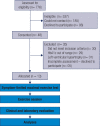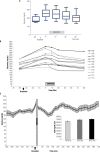Maintenance of plasma glucose variability after an acute session of aerobic exercise despite changes in insulin and glucagon-like peptide-1 levels in type 2 diabetes
- PMID: 35612843
- PMCID: PMC9832849
- DOI: 10.20945/2359-3997000000482
Maintenance of plasma glucose variability after an acute session of aerobic exercise despite changes in insulin and glucagon-like peptide-1 levels in type 2 diabetes
Abstract
Objective: The present study aimed to evaluate glucose variability and hormonal responses during and after an aerobic exercise session performed after breakfast in type 2 diabetes patients treated with metformin.
Methods: In this quasi-experimental study individuals underwent clinical and laboratory evaluations and maximal exercise test. After two weeks an aerobic exercise session (30 minutes at 60%-70% of the peak heart rate) was performed. At rest, during and after the exercise session, glucose variability (mean amplitude glucose excursions, glucose coefficient of variation, and glucose standard deviation) and levels of plasma glucose, insulin, glucagon, and glucagon-like-peptide-1 were evaluated.
Results: Thirteen patients were enrolled in the study. Plasma glucose increased at 15 minutes during the exercise session (244.6 ± 61.9 mg/dL), and decreased at 60 min after exercise (195.6 ± 50.0 mg/dL). Glucose variability did not show any difference before and after exercise. Insulin levels at 15 min [27.1 μU/mL (14.2-42.1)] and 30 min [26.3 μU/mL (14.6-37.4)] during the exercise were higher than those at fasting [11.2 μU/mL (6.7-14.9)] but decreased 60 minutes after exercise (90 minutes) [16.6 μU/mL (8.7-31.7)]. Glucagon levels did not show any difference. GLP-1 levels increased at 30 min [7.9 pmol/L (7.1-9.2)] during exercise and decreased 60 min after exercise (90 minutes) [7.7 pmol/L (6.8-8.5)].
Conclusion: Subjects with type 2 diabetes presented expected changes in insulin, glucagon and GLP-1 levels after breakfast and a single aerobic exercise session, not accompanied by glycemic variability changes.
Keywords: Blood glucose; diabetes mellitus; glycemic variability; hormones.
Conflict of interest statement
Disclosure: the authors did not receive any reimbursement or financial benefits, and they declare that they have no competing interests.
Figures


Similar articles
-
Addition of metformin to exogenous glucagon-like peptide-1 results in increased serum glucagon-like peptide-1 concentrations and greater glucose lowering in type 2 diabetes mellitus.Metabolism. 2011 Jan;60(1):52-6. doi: 10.1016/j.metabol.2010.01.001. Epub 2010 Feb 11. Metabolism. 2011. PMID: 20152998 Clinical Trial.
-
Impact of the timing of metformin administration on glycaemic and glucagon-like peptide-1 responses to intraduodenal glucose infusion in type 2 diabetes: a double-blind, randomised, placebo-controlled, crossover study.Diabetologia. 2024 Jul;67(7):1260-1270. doi: 10.1007/s00125-024-06131-6. Epub 2024 Apr 1. Diabetologia. 2024. PMID: 38561463 Free PMC article. Clinical Trial.
-
Miglitol administered before breakfast increased plasma active glucagon-like peptide-1 (GLP-1) levels after lunch in patients with type 2 diabetes treated with sitagliptin.Acta Diabetol. 2012 Jun;49(3):225-30. doi: 10.1007/s00592-011-0322-9. Epub 2011 Sep 6. Acta Diabetol. 2012. PMID: 21898126 Clinical Trial.
-
The role of glucagon-like peptide 1 in the postprandial effects of metformin in type 2 diabetes: a randomized crossover trial.Eur J Endocrinol. 2024 Aug 5;191(2):192-203. doi: 10.1093/ejendo/lvae095. Eur J Endocrinol. 2024. PMID: 39049802 Clinical Trial.
-
Effects of metformin on glucagon-like peptide-1 levels in obese patients with and without Type 2 diabetes.Diabetes Nutr Metab. 2004 Dec;17(6):336-42. Diabetes Nutr Metab. 2004. PMID: 15887627
References
-
- Umpierre D, Ribeiro PA, Kramer CK, Leitão CB, Zucatti AT, Azevedo MJ, et al. Physical activity advice only or structured exercise training and association with HbA1c levels in type 2 diabetes: a systematic review and meta-analysis. JAMA. 2011;305(17):1790–1799. - PubMed
-
- Haxhi J, Leto G, di Palumbo AS, Sbriccoli P, Guidetti L, Fantini C, et al. Exercise at lunchtime: effect on glycemic control and oxidative stress in middle-aged men with type 2 diabetes. Eur J Appl Physiol. 2016;116(3):573–582. - PubMed
MeSH terms
Substances
Grants and funding
LinkOut - more resources
Full Text Sources
Medical
